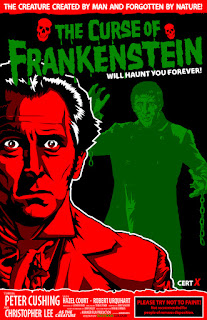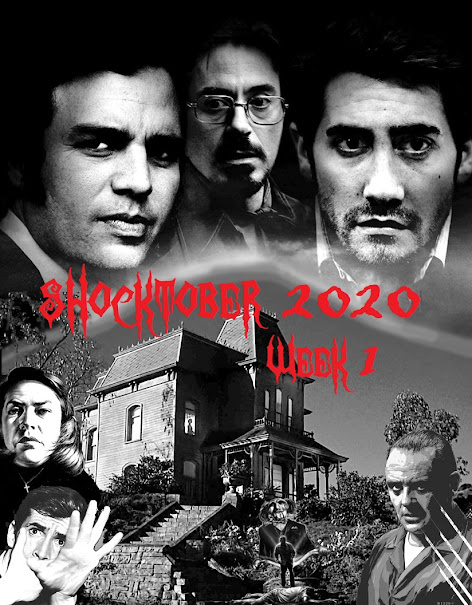This week we watched the first 9 horror films to be produced by Hammer Studios in the wake of the success of The Quatermass Xperiment, which put them on the map.
1. The Quatermass Xperiment (1955)An adaptation of the influential British television serial created by Nigel Kneale, this film is an excellent sci-fi/horror film. Kneale's story is filled with the anxiety about communist subversion (personified by the alien creature that seems to assimilate everything it touches) and serves as a cautionary tale about the dangers of scientific experiments run amok. One is reminded, while watching it, of the fears that people living in the 50's must of had about the prospect of space travel. Val Guest, who directed many of the studios early films, really delivers a suspenseful, atmospheric adaptation. His documentary style and use of hand-held camerawork lends the picture a really grounded, realistic sensibility. Brian Donlevy, who was brought on to attract American audiences, brings a real brusqueness and all-business attitude to the role of Prof. Bernard Quatermass, whose attempt at space travel leads to all the trouble. The real star of the film, however, is Richard Wordsworth, who plays the possessed astronaut Victor Carroon with real conviction. He gives the alien creature a really monstrous quality, largely without the aid of make-up.
Score: 9/10
2. X the Unknown (1956)
Another fine sci-fi horror film from Hammer, X the Unknown shifts the focus from space (as in Quatermass, which this was originally intended as a sequel to) to the depths of the earth. Dean Jagger, brought on like Brian Donlevy to attract American audiences, is great as the reserved, humanistic Dr. Adam Royston, and his British co-stars all do a fine job as well. It lacks the paranoia of Kneale's story and the monster is nowhere near as frightening as it was in The Quatermass Xperiment, though the effects work is great, anticipating The Blob (1958). A solid picture nonetheless.
Score: 8/10
3. The Curse of Frankenstein (1957)The film that really established Hammer's distinctive brand of Gothic horror The Curse of Frankenstein was a major success for the studio. The film distinguishes itself from Universal's more famous version of Mary Shelley's story by focusing less on the monster (here played by Christopher Lee) and more on Baron Frankenstein (Peter Cushing) and his macabre experiments. Unlike Colin Clive, who played the character as obsessive but still morally centered, Cushing's Frankenstein is an unscrupulous, unfeeling maniac, focused only on completing his blasphemous experiment. This was the first Hammer film to be directed by Terence Fisher, who would become the studio's greatest auteur, and he establishes many of his trademarks in this film. It is framed as a moral struggle between Frankenstein and his mentor Paul Krempe (Robert Urquhart), who was a minor character in the novel. It really pushed the boundaries for onscreen violence, and received an X certificate from the censors in England. It was also the studio's first color film, and it is visually a sight to behold. It may not live up to Whale's film but it doesn't really try to, and it remains a stirring, gruesome chamber piece.
Score: 9/10
4. The Abominable Snowman (1957) Another of the studio's black-and-white sci-fi horror films, The Abominable Snowman also features elements of fantasy. Based, once again, on a television serial by Nigel Kneale, the film has echoes of Lovecraft's At the Mountains of Madness, with a team of scientists encountering an ancient race who's apparent superiority to humans is a source of horror. Peter Cushing is much more sympathetic here as the dedicated scientist Dr. Rollason. His unethical partner, Dr. Tom Friend, is played less effectively by Forrest Tucker (brought on once again to bring in U.S. audiences). Val Guest directs effectively, building the tension and sense of mystery as the film goes on. The denouement is a bit rushed and I found the film's post-humanist themes a bit repugnant, but it's a solidly made film with a paranoid atmosphere and a taut sense of suspense.
Score: 8/10
5. Quatermass 2 (1957)
Based, like the first film, on the Nigel Kneale BBC serial, Quatermass 2 shifts the focus away from outer space toward government conspiracies and, like the first film, echoes cold war fears about ideological subversion. Brian Donlevy returns as the resolute Professor Quatermass who, in this film, has restarted his space program and now has designs to start a colony on the moon. When he stumbles on a top-secret government program remarkably similar to the one he has proposed, he is lead deeper and deeper into a nefarious conspiracy that ultimately proves to be of extraterrestrial origin. Quatermass 2 feels indebted, to some extent, to Don Siegal's Invasion of the Body Snatchers (1956) and, thanks largely to Val Guest's steady direction (borrowing, once again from cinema verite' techniques) is quite effective, if ultimately less satisfying then the first film.
Score: 8/10
6. Dracula (1958) Terence Fisher's second film for the studio is a masterpiece. Bram Stoker's novel is stripped down to it's barest essential's and the action is condensed to a smaller geographical area. Though it lacks the richness of its source material as a result of this the film still retains its Victorian sensibilities and sense of sexual allure attached to its titular antagonist. The film reunites Peter Cushing and Christopher Lee, who would go on to appear in more then 20 films together and would eventually become great friends. Even more then in The Curse of Frankenstein there is an underlying moral struggle between good, here exemplified by Cushing's Dr. Van Hesling, and evil, exemplified by Lee's creature of the night, that drives the film. Fisher's amps up the novel's sexual tension and focuses more on it's religious imagery then the 1931 Universal film had. James Bernard's score is magnificent, and the cinematography and set design are impeccable. As an adaptation of Stoker's novel, it is rivaled only by Murnau's Nosferatu.
Score: 10/10
7. The Revenge of Frankenstein (1958)
Even more grisly then The Curse of Frankenstein, Revenge is also more thematically complex then it's predecessor. The monster here is a hunchback (Oscar Quitak), crippled from birth, for whom Frankenstein makes a new body. All seems well at first but when the now normal looking creature is beat up while sneaking into the doctor's lab, his brain malfunctions, and he starts attacking people. It seems to me that the story could be viewed as a sort of refutation of Gnosticism, with the exchanging of one body for another destroying the integral union between body and soul. In any case this is a solid sequel. Peter Cushing is, once again, great as the mad doctor but it's Michael Gwynn, playing the hunchback in his new body, that steals the show. He is particularly brilliant in the scene where he is punched around by George Woodbridge's drunken janitor, and the inner monster comes out. With that said, the plot is a little contrived at times and the film is lacking in focus in comparison to its predecessor. It lacks a likable protagonist like Krempe from the first film.
Score: 8/10
8. The Hound of the Baskervilles (1959)
It seems clear, in adapting this most well known of Sherlock Holmes stories that the filmmakers wanted to avoid treading on familiar
territory, so this film takes liberties with the source material while
still remaining true to it. The result is an excellent adaptation that amps up the blood and violence in comparison to the novel (and the 1939 film with Basil Rathbone). Peter Cushing makes for an excellent Holmes (if a little more temperamental then usual) while André Morell's Watson is a welcome change from Nigel Bruce's more bumbling take on the character (though I do quite like Bruce in the role). Christopher Lee appears with Cushing once again, here playing a rather stern Sir Henry Baskerville while Marla Landi plays this films feisty version of Mrs. Stapleton (here the daughter, rather then the sister, of Baskerville's neighbor). The film has plenty of atmosphere and tension, likely thanks to director Terence Fisher but is marred by some rather poor day-for-night shooting and by a slower moving plot that indulges a few times too often in lengthy scenes of comic relief.
Score: 8/10
9. The Mummy (1959)
A pretty good update of the 1932 Universal film, The Mummy benefits from Jack Asher's color cinematography, which really works with the film's exotic subject matter. Peter Cushing puts in a strong perfomance as the archeologist John Banning while Christopher Lee is at his best as the vengeful, obsessive Kharis. Eddie Byrne plays off of Cushing well as the skeptical police inspector, Mulrooney while George Pastell's hides a deep-seated fanaticism beneath a veneer of respectability as the vengeful worshiper of Karnak, Mehemet Bey. It's sluggishly paced at times, even more so then the Universal film, but I enjoyed it more, partly because of the cast but mainly because the stellar production design and sense of atmosphere.
Score: 8/10
Next week, I'll look at the Nightmare on Elm Street franchise as well as the last few Friday the 13th films, stay tuned!


































